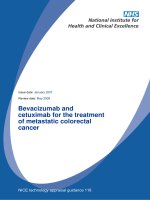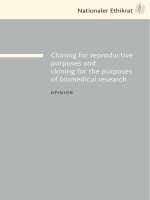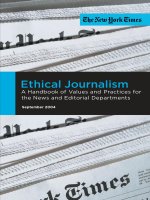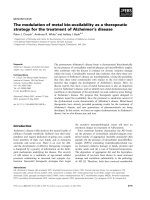Evaluation of selected bio agents, plant extracts and fungicides for the management of Alternaria Leaf blight of Indian mustard
Bạn đang xem bản rút gọn của tài liệu. Xem và tải ngay bản đầy đủ của tài liệu tại đây (161.11 KB, 6 trang )
Int.J.Curr.Microbiol.App.Sci (2017) 6(4): 26-31
International Journal of Current Microbiology and Applied Sciences
ISSN: 2319-7706 Volume 6 Number 4 (2017) pp. 26-31
Journal homepage:
Original Research Article
/>
Evaluation of Selected Bio Agents, Plant Extracts and Fungicides for the
Management of Alternaria Leaf Blight of Indian Mustard
Kuldeep Singh*, Abhilasha A. Lal, Dinesh Kumar and Neeraj Kumar Meena
Department of Plant Pathology, Allahabad School of Agriculture, Sam Higgin bottom Institute of
Agriculture, Technology and Sciences, Allahabad – 211 007, India
*Corresponding author
ABSTRACT
A field experiment was conducted at the research plot of the Department of Plant
Pathology, SHIATS, Allahabad, U.P. during the Rabi season of 2013-14 to evaluate
Alternaria blight,
selected bioagents, plant extracts and fungicides for the management of Alternaria blight
Bio agents,
of Indian mustard (Brassica juncea L.) by applying foliar sprays of certain fungicides plant
Fungicides, Garlic
extract and bio-agents. Per cent disease intensity on leaves at 75 DAS, per cent Alternaria
bulb extract, Indian
pod blight at 90 DAS, test weight (g/1000 seeds) and yield (q/ha) were recorded. Results
mustard, Plant
revealed that foliar spray of mancozeb at 75 DAS recorded lowest per cent disease
height, Test weight.
intensity on leaves (36.76) and pods (20.53) as compared to control (61.03 and 37.9,
Article Info
respectively). The same treated recorded maximum plant height at 60 DAS and 90 DAS
(106.66 cm and 162.6 cm, respectively). Maximum test weight of 1000 seeds and yield
Accepted:
q/ha were also in the same treatment (5.04g and 13.38q/ha., respectively) as compared to
02 March 2017
the control (4.11g and 9.04 q/ha., respectively). Results showed that the foliar spray of
Available Online:
mancozeb @ 2.5g/l significantly reduced Alternaria blight, increased yield and was the
10 April 2017
most effective treatment, followed by garlic bulb extract @ 15% (w/v), neem leaf extract@
15% (w/v), Trichoderma harzianum@ 10g/l, carbendazim 50 WP @ 2g/l and
Pseudomonas fluorescens @ 10g/l. However, the treatments viz. garlic bulb extract, neem
Introduction
leaf extract were at par with the mancozeb treatment in reducing the disease intensity and
the yield (q/ha). In future these botanicals can be taken up to minimize the
Mustard (Brassica increasing
juncea L.)
is one of the
friendly alternatives for the management of
losses caused by this disease.
Keywords
major oil seed crop in India during Rabi
season. It occupies a prominent place being
next in importance to ground nut, both in area
and production. Alternaria blight is a
common disease in mustard. This is caused by
Altrernaria brassicae (Berk.) Sacc. and A.
brassicicola (Schw.).This disease is reported
from all continents of the world, and is
reported to cause losses upto 70% depending
on the crop species Kolte et al., (1987) and
Chattopadhyay (2008). It is soil, air and seed
borne disease. In the present day scenario
when the concern regarding environmental
pollution is at its peak a need to evaluate eco-
Alternarial blight was felt and an experiment
was planned with botanicals, bio-agents and
fungicides Mukhopadhyay (1994); Meena et
al., (2004). Currently pertaining to the use of
botanicals in management of pathogens and
related diseases are highly focused (Koche,
2013; Toppo, 2013; Mathad et al., 2013;
Mahapatra, 2013; Bisht, 2013). The paper
deals with the evaluation of selected bioagents and plant extracts along with the
conventional fungicides against this important
disease of mustard which causes losses. The
approach was aimed to come up with
alternative as the indiscriminate use of
26
Int.J.Curr.Microbiol.App.Sci (2017) 6(4): 26-31
fungicides is hazardous to the environment
and affect human health. So, the present study
was conducted to with a motive to come up
with an eco-friendly management strategy
which could be at par with the conventional
fungicides used.
bulb extract 15%), bio agents (Trichoderma
harzianum 1% and Pseudomonas fluorescens
1%), fungicides [mancozeb 75% WP (0.25%),
carbendazim @ 50WP (0.2%)] in their
respective doses reduced the leaf blight
severity and subsequently increased the yield
and cost benefit ratio in comparison to
untreated control (check).
Materials and Methods
The experiment was carried out in the
research plot of the Department of Plant
Pathology, SHIATS, during 2013-2014 under
natural conditions. The crop was sown in
randomized block design with three
replications, seven treatments including
control. Two botanicals [neem leaf extract
(15%), garlic bulb extract (15%), two bio
agents
(Trichoderma
harzianum
1%,
Pseudomonas fluorescens 1%) and two
fungicides [mancozeb 75% WP (0.25%),
carbendazim @ 50WP (0.2%)] were selected
and these were sprayed separately after 50
days of sowing (Meena et al., 2011; Singh
and Singh, 2007; Chaudhary et al., 2013 and
Mahapatra and Das 2013). The foliar spray
was repeated after 15 days of first spray.
Observations on per cent disease intensity on
leaf at 75 DAS and pod at 90 DAS, plant
height (60, 90 DAS), test weight (g/1000
seeds) and yield (q/ha) were recorded.
Aqueous extracts of two botanicals (15 %)
were prepared individually Mahapatra and
Das (2013). Per cent disease intensity was
recorded on leaves and pods at 15 days
interval following 0-9 disease rating scale
Singh (2009), per cent disease intensity was
calculated using Mc Kinney’s (1923) formula
(Per cent disease intensity = Sum of all
individual rating x 100/ Total number of
leaves observed x maximum rating).
The results showed botanicals, bio agents and
fungicides reduced the per cent leaf/pod
infection significantly in comparison to
control. Minimum per cent disease intensity
(36.76 %) at 75 DAS was recorded in
mancozeb 75% WP sprayed plots. This was
followed by garlic bulb extract @ 15 %
(38.47 %), neem leaf extract @ 15 % (40.76
%), T. harzianum @1 % (42.66 %),
carbendazim @ 0.2 % (47.61 %) and P.
fluorescens @ 1 % (51.25 %) as compared to
control (61.03 %). The minimum disease
intensity on pods (20.53 %) at 90 DAS was
recorded in mancozeb treated plots. This was
followed by garlic bulb extract @15% (23.2
%), neem leaf extract @ 15 % (25.55 %), T.
harzianum @1 % (27.0 %), carbendazim @
0.2 % (32.68 %) and P. fluorescens @ 1 %
(37.9 %) as compared to control (44.59) as
given in table 1. Thus, mancozeb @ 0.25 %
provided superior results in all the treated
plots. Similar findings have been reported by
Jagana et al., (2013). They have reported that
Dithane M-45 was the most effective
fungicide for Alternaria leaf blight in mustard
crop.
In the present study among the plant extracts
tested garlic bulb extract @ 15 % was found
to be better in decreasing the disease
intensity. Similar findings have been reported
by Meena and Sharma (2012). The probable
reason for such finding may be that ajoene, a
compound derived from garlic may have
inhibited spore germination of Alternaria sp.
It is reported that the compound has
effectively checked spore germination at a
concentration of 25 µg/ml and recorded 100
Results and Discussion
Disease parameters
The results revealed that spraying of
botanicals (neem leaf extract 15%, and garlic
27
Int.J.Curr.Microbiol.App.Sci (2017) 6(4): 26-31
% inhibition. It is quite likely that compound
may be useful in controlling disease under
field conditions. Similar findings have been
reported by Singh et al., (1990).
for plant height (cm). Amongst the bio-agents
tested maximum plant height of mustard was
recorded in T. harzianum (150.97 cm).
Similar findings have been reported by
Muhammad et al., (2003) and Islam et al.,
(2008).
Growth parameters
The growth parameters e.g. maximum plant
height was recorded in plants sprayed with
garlic bulb extract @ 15 % (167.01 cm) at 90
DAS which was at par with mancozeb (162.6
cm) and neem leaf extract @ 15% (158.03
cm) and followed by T. harzianum @ 1 %
(150.97 cm), carbendazim @0.2 % (144.38
cm) and P. fluorescens @ 1 % (137.26 cm) as
compared to control (135.73 cm) as given in
table 1. Similar results have been observed by
Perello et al., (2013). They reported that
garlic bulb extract was found to be the most
effective treatment for improving the seedling
health and plant height on wheat. While,
Yadav et al., (2002) have reported that
mancozeb was the most effective fungicide
Yield parameters
The maximum test weight were recorded in
mancozeb treated plots(5.04 g) which was at
par with garlic bulb extract @ 15 % (4.91 g)
and neem leaf extract @ 15 % (4.89 g) and
followed by carbendazim (4.72 g), P.
fluorescens (4.68 g) and T. harzianum (4.49
g) as compared to control (4.11 g) as given in
table 1. Similar results were recorded by Patni
and Kolte (2006). They reported that the
maximum test weight (g/1000 seeds) was
observed in mancozeb sprayed plants (4.22
g).
Table.1 Alternaria blight of Indian mustard as affected by selected bio agents, plant extracts and
fungicides
Treatments and
Concentration
PDI on
leaf at
75 DAS
Control
61.03
Trichodermaharzi 42.66
anum (1%)
Pseudomonas
51.25
fluorescens (1%)
Neem leaf
40.76
extract (15 %)
Garlic bulb
38.47
extract (15 %)
Mancozeb 75 %
36.76
WP (0.25 %)
Carbendazim 50
47.61
% WP (0.2 %)
S. Ed. (±)
0.704
C. D. (P = 0.05)
1.534
PDI on
pod at
90 DAS
37.9
27.0
Plant height (cm)
60 DAS
87.53
95.98
90 DAS
135.73
150.97
4.11
4.49
35.04
85.86
137.26
4.68
25.55
102
158.03
4.89
23.2
104.14
167.01
4.91
20.53
106.66
162.6
5.04
32.68
92.88
144.38
4.72
0.905
1.972
3.129
6.818
4.863
10.598
0.130
0.283
28
Test weight
g/1000 seeds
Yield q/ha
9.04
11.95
10.12
12.68
12.91
13.38
10.57
0.835
1.820
Int.J.Curr.Microbiol.App.Sci (2017) 6(4): 26-31
Table.2 Economics of treatments against Alternaria leaf blight of Indian mustard
Treatments
Doses
Trichoderma
1%
harzianum
Pseudomonas
1%
fluorescens
Neem leaf
15 %
extract
Garlic bulb
15 %
extract
Mancozeb
0.25 %
Carbendazim 0.2 %
Control
-----
Cost
of
treat.
/kg
Yield
(q/ha)
Additional
yield over
control
(q/ha)
Additional
income
( /ha)
Cost of
Protection
( /ha)
Net
return
( /ha)
Benefit
cost
ratio
75
11.95
2.91
8148
1125
7023
7.24
70
10.12
1.08
3024
1050
1974
2.88
10
12.68
3.64
10192
2250
7942
4.52
60
12.91
3.87
10836
1350
9486
8.02
350
560
-----
13.38
10.57
9.04
4.34
1.53
------
12152
4284
------
1311
1680
------
10841
2604
-----
9.26
2.55
-----
In the present study, the highest yield was
recorded in mancozeb treatment (13.38 q/ha)
which was at par with garlic bulb extract @
15 % (12.91 q/ha), neem leaf extract @ 15 %
(12.68 q/ha) and T. harzianum @1 % (11.95
q/ha) and followed by carbendazim (10.57)
and P. fluorescens @ 1 % (10.12 %) as given
in table 1. Patni and Kolte (2006) reported
that the maximum number of pods on main
raceme was observed in mancozeb treatment.
Similar results were recorded by Jagana et al.,
(2013). They reported that mancozeb
recorded the highest yield in mustard and was
the most effective fungicide. Similar results
were also recorded by Girish et al., (2007).
Amongst the bio-agents maximum yield q/ha
was recorded in T. harzianum. The probable
reason may be that Trichoderma spp. may
have enhanced the plant growth as such the
yield (q/ha) in the present study was found to
be statistically superior over control. Similar
findings have been reported by (Gupta and
Srivastav, 1976; Kamlesh and Gurjar, 2001;
John et al., 2010; Shabir and Rubina, 2010).
(9.26) followed by foliar spray of garlic bulb
extract @ 15 % (w/v) (8.02), T. harzianum @
10 g/l (7.24), neem leaf extract(w/v) @ 15 %
(4.52), Pseudomonas fluorescens @ 10 g/l
(2.88) and carbendazim @ 2 g/l (2.55) as
given in table 2. Similar results were recorded
by Chattopadhyay and Bhunia (2003). They
reported that highest seed yield and
significant increase of 1000-seed weight were
recorded from single spray of iprodione at
post-flowering stage. But maximum economic
return was obtained from two spray of
mancozeb at 45 DAS and 60 DAS.
The results proved that application of
botanicals could be bio-pesticidal and ecofriendly substitute for chemical fungicides in
management of Alternaria leaf blight of
Indian mustard. The success of garlic bulb
extract and neem leaf extract in minimizing
the disease intensity on both leaves and pods
which are similar with earlier reports of
Meena et al., (2008), the results also are in
conformity with the ones reported by
Chatopadhyay et al., (2005) in which they
revealed that both garlic bulb extract and
neem leaf extract were the better choice than
the conventional chemical fungicides which
are fast in action but there indiscriminate use
Cost benefit ratio
In the present study the maximum cost benefit
ratio was recorded in mancozeb @ 2.5 g/l
29
Int.J.Curr.Microbiol.App.Sci (2017) 6(4): 26-31
Chaudhary, A., S. Zacharia, and A.A. Lal. 2013.
Effect of fungicides, bio-agents and garlic
blub extract in management of Alternaria
blight of mustard. Ann. Pl. Protec. Sci.,
21: 222-223.
Girish, G., M. Gowda, B. Saifulla, M. Mahesh
and M. Satheesh. 2007. Management of
white rust and Alternaria leaf blight of
mustard using fungicides. Environ. Eco.,
25(3A): 830-833.
Gupta, J.H. and U.P. Srivastava. 1976. A new
root rot of fennel caused by Fusarium
solani. J. Mycol. Pl. Pathol., 8: 206.
Islam, M.T. and A.N. Farug. 2008. Effects of
selected soil management on seed
germination, seedling growth and control
of damping off of chilli. J. Bangladesh
Agri. Univ., 2: 12-16.
Jagana, M., S. Zacharia, A.A. Lal and Basayya.
2013. Management of Alternaria blight in
mustard. Ann. Pl. Protec. Sci., 21(2): 441442.
John, R.D., D. Tyagi, S.K. Prévost, S.P. Brar,
R.Y. Surampalli and P. Rojan. 2010.
Mycoparasitic Trichoderma viride as a
biocontrol agent against Fusarium
oxysporum
f.
sp.
and
Pythium
arrhenomanes and as a growth promoter
of soybean. Cr. Protec., 29: 1452-1459.
Kamlesh and R.B.S. Gurjar. 2001. Rhizoctonia
solani a new threat to chill in Rajasthan.
Mycol. Pl. Pathol., 31(2): 261.
Koche, M.D., R.M. Gade and A.G. Deshmukh.
2013. Antifugal activity of secondary
metabolites produced by Pseudomonas
fluorescens. The Biosc., 8(2): Suppl.
Medi. Pl. 723-726.
Kolte, S.J. 1987. Diseases of annual edible
oilseed crops. Vol. II, Rapeseed-mustard
and sesame disease. CRC Press Inc. Boca
Raton, Florida, pp 135.
Mahapatra, S. and S. Das. 2013. Bio efficacy of
botanicals against Alternaria leaf blight
of mustard under field condition. The
Biosc., 8(2): 675-679.
Mathad, R.C., N.M. Shakuntala, S.N.
Vasudevan, M.N. Naik and S.B. Patil.
2013. The anti-fugal properties of
aqueous
extracts
from
Psorolea
can be hazardous. So, the results proved that
two foliar sprays at 50 and 65 DAS of garlic
bulb extract and neem leaf extract could be
bio-pesticidal, eco-friendly, equally effective
as mancozeb and may become the substitude
for chemical fungicides in management of
Alternaria leaf blight of mustard. This
experiment therefore, suggest that water
extractable plant extract may in future be
recommended
as
biologically
based
management strategy and can be made
available in user friendly formulations for the
management of Alternaria leaf blight disease
of Indian mustard.
Acknowledgements
The authors are thankful to the Hon’ble Vice
Chancellor,
SHIATS,
Allahabad,
for
providing necessary facilities in carrying out
the present investigation.
References
Bisht, S., P. Kumar, A. Srinivasanraghvan and
J. Purohit. 2013. In vitro management of
Curvularia leaf spot of maize using
botanicals, essential oils and bio-control
agents. The Biosc., 8(2): Suppl. Medi. Pl.,
731-733.
Chattopadhyay, A.K. and C.K. Bhunia. 2003.
Management of Alternaria leaf blight of
rapeseed-mustard by chemicals. J.
Mycopathol. Res., 41(2): 181-183.
Chattopadhyay, C. 2008. Management of
diseases of rapeseed mustard with special
reference to Indian conditions. In:
sustainable production of oilseed:
rapeseed mustard technology (Eds: A.
Kumar, J. S. Chauhan, and C.
Chattapadhyay), Agro. Pub. Acad.,
Udaipur, pp: 364-368.
Chattopadhyay, C., P.D. Meena, S. Godika, M.
S. Yadav, R.L. Meena, and C.K. Bhunia.
2005. Garlic bulb extract a better choice,
than chemical fungicides in managing
oilseed crop diseases. J. Mycol. Pl. Path.,
35: 574-575.
30
Int.J.Curr.Microbiol.App.Sci (2017) 6(4): 26-31
corylifolia Linn. seeds in controlling grain
smut and seed quality enhancement of
sorghum. The Biosc., 8(2): Suppl. Medi.
Pl. 685-687.
Mckinney, H.H. 1923. A new system of grading
plant diseases. J. Agri. Res., 26: 195-218.
Meena, P.D., R.L. Meena, C. Chattopadhyay
and A. Kumar. 2004. Identification of
critical stage for disease development and
bio control of Alternaria blight of Indian
mustard. J. Phytopathol., 152: 204-209.
Meena, P.D., R.P. Awasthi, S. Godika, J.C.
Gupta, A. Kumar, P.S. Sandhu, P.
Sharma, P.K. Rai, Y.P. Singh, A.S. Rathi,
R. Prasad, D. Rai and S.J. Kolte. 2011.
Eco-friendly approaches managing major
diseases of Indian mustard. Worl. Appl.
Sci. J., 12(8): 1192-1195.
Meena, P.D. and P. Sharma. 2012. Antifungal
activity of plant extracts against
Alternaria brassicae causing blight of
Brassica spp. Ann. Pl. Prot. Sc., 17: 256257.
Meena, P.D., C. Chattopadhyay and R.L.
Meena. 2008. Eco-friendly management
of Alternaria blight in Brassica junncea.
Ind. Phytopathol., 61: 65-69.
Muhammad, S. and N.A. Amusa. 2003. In vitro
inhibition of growth of some seedling
blight inducing pathogen by compost
inhibiting microbes. Afric. J. Biotechnol.,
2(6): 161-161.
Mukhopadhyay, A.N. 1994. Biocontrol of soil
borne plant pathogens, current status,
future prospects and potential limitations.
Ind. Phytopathol., 47: 119-126.
Patni, C.S. and S.J. Kolte. 2006. Effect of some
botanicals in management of Alternaria
blight of rapeseed mustard. Ann. Pl.
Protec. Sci., 14: 151-156.
Perello, A., M. Gruhlke and A.J. Slusarenko.
2013. Effect of garlic extract on seed
germination, seedling health and vigour
of pathogen infested wheat. J. Pl. Protec.
Res., 53(4): 317-323.
Shabir, L. and Rubina. 2010. Biological control
of damping off disease of cabbage caused
by Rhizoctonia solani (Kuhn) Appl. Biol.
Res., 12: 38-41.
Singh, R. and V.K. Singh. 2007. Evaluation of
fungicides against Alternaria blight of
Brassica campestris var. yellow sarson.
Ann. P. Prot. Sci., 15(1) 235-281.
Singh, R.S. 2009. Introduction to principles of
plant pathology, fourth edition, Oxford
and IBH Publication Pvt. ltd. New Delhi,
pp-290-291.
Singh, U.P., V.N. Pandey, K.G. Wagher and
K.P. Singh. 1990. Antifungal activity of
ajoene, a constituent of garlic (Allium
sativum. Can. J. Bot., 68(6): 1354-1356.
Toppo, K.I., S. Gupta, D. Karkun, S. Agrawal
and A. Kumar. 2013. Antimicrobial
activity of Sphagneticola trilobata (L.)
Pruski, against some human pathogenic
bacteria and fungi. The Biosc., 8(2):
Suppl. Medi. Pl. 695-700.
Yadav, M.S., S.S. Dhillon and J.S. Dhiman.
2002. Effect of date of sowing, varieties
and chemical treatments on the
development of Alternaria blight and
white rust of mustard. J. Res., 39(4): 528532.
How to cite this article:
Kuldeep Singh, Abhilasha A. Lal, Dinesh Kumar and Neeraj Kumar Meena. 2017. Evaluation of
Selected Bio Agents, Plant Extracts and Fungicides for the Management of Alternaria Leaf Blight
of Indian Mustard. Int.J.Curr.Microbiol.App.Sci. 6(4): 26-31.
doi: />
31









